The vehicle acoustic DSP chips market reaches USD 867.1 million in 2025 and is estimated to expand to USD 1,754.2 million by 2035, registering a CAGR of 7.3%. From 2021 to 2025, the market is projected to progress from USD 609.7 million to USD 867.1 million, passing through USD 654.2 million, USD 701.9 million, USD 753.2 million, and USD 808.1 million. This growth is fuelled by rising demand for advanced sound and noise management systems in vehicles, as automakers focus on enhancing in-car audio and noise reduction features. The growing integration of infotainment systems, voice recognition, and active noise cancellation systems, especially in premium vehicles, supports the steady rise in demand for acoustic DSP chips during this period.
Between 2026 and 2030, the market advances from USD 867.1 million to USD 1,233.3 million, passing through USD 930.4 million, USD 998.3 million, USD 1,071.2 million, and USD 1,149.4 million. Growth in this phase is supported by the adoption of more sophisticated DSP chip technologies, which enable features such as 3D sound, real-time adaptive acoustics, and enhanced audio quality in electric vehicles (EVs). With EVs gaining traction and quiet engines requiring advanced acoustic solutions, the demand for high-performance DSP chips rises.
By 2035, the market is expected to reach USD 1,754.2 million, having passed through USD 1,233.3 million, USD 1,420.0 million, USD 1,523.6 million, and USD 1,634.9 million, and ultimately reaching USD 1,754.2 million, as the continued evolution of automotive audio technology and rising consumer preferences for enhanced in-cabin audio experiences drive strong market expansion.
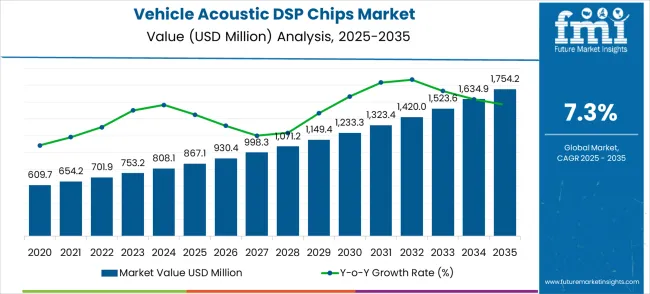
Market expansion unfolds through two distinct growth periods with different technological characteristics for each phase. The 2025-2030 acceleration period delivers USD 456.3 million in value additions, representing 52.6% growth from the baseline. Market dynamics during this phase center on electric vehicle mainstream adoption, premium audio system standardization, and automotive OEM integration acceleration.
The 2030-2035 maturation period generates USD 430.8 million in incremental value, reflecting 32.6% growth from the 2030 position. This phase exhibits mature technology characteristics with enhanced performance requirements, advanced noise cancellation integration, and autonomous vehicle audio system initiatives. Dollar contributions shift from foundational electric vehicle infrastructure to sophisticated audio processing optimization and next-generation automotive computing.
Competitive landscape evolution progresses from early electric vehicle audio adoption to established premium infotainment positioning. The first period emphasizes technology validation and audio performance optimization. The second period witnesses intensified competition for premium automotive segments and advanced audio processing territory expansion. Market maturation factors include standardized audio specifications, integrated noise control capabilities, and cross-platform application development across electric vehicles, autonomous systems, and premium automotive infotainment sectors.
| Metric | Value |
|---|---|
| Market Value (2025) → | USD 867.1 million |
| Market Forecast (2035) ↑ | USD 1,754.2 million |
| Growth Rate ↑ | 7.3% CAGR |
| Segment Leader → | Multi-core DSP |
| Application Focus ★ | Passenger cars |
Market expansion rests on five fundamental shifts driving automotive audio processing demand acceleration:
The growth faces headwinds from semiconductor supply chain constraints and increasing component complexity costs. Traditional analog audio systems maintain cost advantages for entry-level vehicles. Technical integration challenges create adoption barriers for smaller automotive manufacturers lacking advanced engineering capabilities.
Primary Classification: Core Architecture Distribution
Secondary Breakdown: Application Categories
Geographic Segmentation: Regional Market Distribution
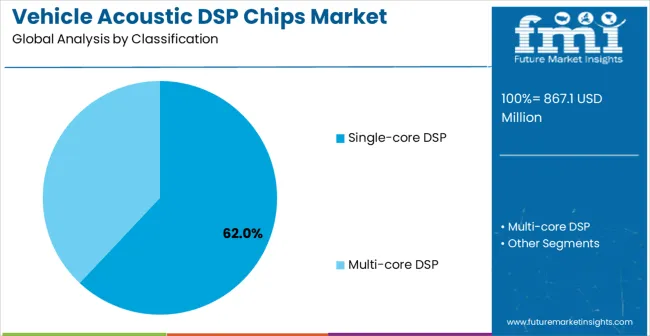
Market Position: Multi-core DSP chips establish clear market leadership through parallel processing advantages and enhanced computational capabilities. Advanced multi-core architectures enable simultaneous audio processing tasks including noise cancellation, voice recognition, and premium sound enhancement. Scalable processing power accommodates varying performance requirements across different vehicle segments.
Value Drivers: Multi-core designs deliver superior audio processing performance through dedicated core allocation for specific functions. Parallel processing capabilities enable real-time noise cancellation while maintaining high-quality audio reproduction. Power efficiency optimization reduces energy consumption critical for electric vehicle applications.
Competitive Advantages: Multi-core systems offer flexible resource allocation adapting to dynamic audio processing requirements. Advanced algorithms utilize multiple cores for complex audio enhancement and spatial processing. Integration capabilities enable seamless connectivity with vehicle infotainment and safety systems.
Market Challenges: Higher development costs increase system integration expenses compared to single-core alternatives. Complex programming requirements need specialized engineering expertise not available in all automotive facilities. Power management complexity may impact battery performance in electric vehicle applications.
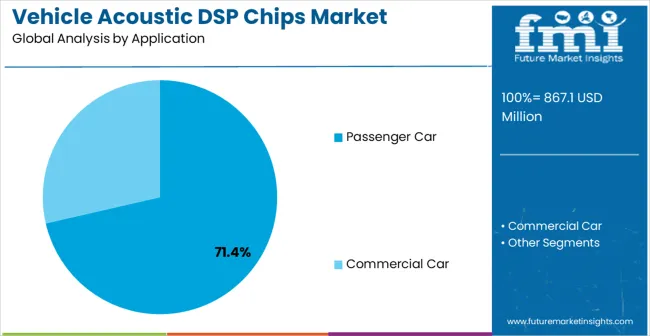
Strategic Market Importance: Passenger car applications represent the primary demand driver for vehicle acoustic DSP chips across automotive audio system integration and infotainment development. Consumer vehicles require advanced audio processing for entertainment, communication, and safety enhancement systems. Premium passenger car segments demand sophisticated noise cancellation and immersive audio experiences.
Market Dynamics Q&A:
Business Logic: Passenger vehicles prioritize occupant comfort and entertainment, making advanced audio processing essential for market competitiveness. Consumer expectations drive adoption of premium audio features requiring sophisticated DSP capabilities. Cost justification occurs through enhanced vehicle value proposition and improved customer satisfaction.
Forward-looking Implications: Autonomous passenger vehicle development creates new audio processing requirements for entertainment and communication systems. Connected car services expansion increases demand for advanced audio processing supporting streaming and voice interaction capabilities. The growth of the electric vehicle market sustains demand for passenger car audio processing across emerging automotive technologies.
Growth Accelerators: Electric vehicle mainstream adoption drives demand for advanced noise cancellation and audio processing across automotive production lines. Premium infotainment system integration creates requirements for high-performance DSP solutions supporting multi-zone audio and voice recognition. Autonomous driving development necessitates sophisticated audio processing for safety alerts and cabin communication systems. Consumer audio quality expectations favor advanced DSP solutions providing immersive listening experiences and seamless smartphone integration. Regulatory safety standards mandate acoustic warning systems and emergency sound detection requiring specialized audio processing capabilities.
Growth Inhibitors: Semiconductor supply chain constraints create availability challenges and cost pressures for automotive DSP chip procurement. Component complexity increases system integration expenses and engineering requirements beyond capabilities of smaller automotive manufacturers. Power consumption concerns in electric vehicles may limit adoption of high-performance DSP solutions. Cost sensitivity in entry-level vehicle segments restricts advanced audio processing adoption. Technical integration complexity requires specialized expertise creating adoption barriers for traditional automotive suppliers.
Market Evolution Patterns: AI integration enables intelligent audio processing with adaptive noise cancellation and personalized sound enhancement. Edge computing capabilities reduce latency and improve real-time audio processing performance. Integration with vehicle connectivity platforms enables over-the-air updates and feature enhancement. Power efficiency improvements extend electric vehicle range while maintaining premium audio performance.
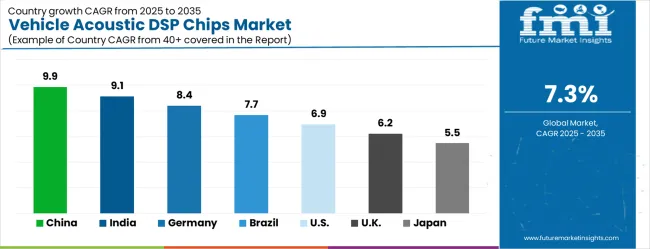
| Country | CAGR (2025-2035) |
|---|---|
| China | 8.1% |
| India | 8.6% |
| Germany | 6.2% |
| Brazil | 7.4% |
| United States | 5.8% |
| United Kingdom | 5.5% |
| Japan | 5.2% |
Global market dynamics reveal distinct performance tiers reflecting regional automotive manufacturing capabilities and consumer technology adoption levels. Growth Leaders including China (9.9% market share) and India (9.1% share) demonstrate expanding automotive electronics ecosystems with advanced audio system integration, while Germany (8.4% share) represents European automotive engineering excellence. Steady Performers such as Brazil (7.7% share) and the United States (6.9% share) show consistent demand growth aligned with electric vehicle adoption and premium infotainment development. Mature Markets including the United Kingdom (6.2% share) and Japan (5.5% share) display moderate growth reflecting established automotive industries with technology advancement focus.
Regional synthesis indicates Asia Pacific dominance through automotive manufacturing concentration and consumer electronics integration capabilities, LED by China's extensive production capacity and India's growing automotive market. European markets emphasize premium audio technology and engineering excellence, with Germany's automotive industry leadership. North American demand reflects consumer preference for advanced infotainment systems and electric vehicle adoption initiatives.
The report provides an in-depth analysis of over 40 countries, with the top-performing countries highlighted below.
China establishes market leadership through automotive manufacturing dominance and electric vehicle production leadership across global supply chains, demonstrating a robust 9.8% CAGR reflecting extensive manufacturing capacity expansion. Government electric vehicle mandates drive adoption of advanced audio processing systems for noise compensation and premium infotainment integration. Market dynamics center on domestic semiconductor development and automotive electronics manufacturing capability expansion targeting global competitiveness.
Manufacturing ecosystem concentration enables cost optimization through supply chain integration and technical expertise development supporting international market penetration. State investment in automotive electronics supports market growth through research and development initiatives focusing on AI-enhanced audio processing technologies. Export production requirements necessitate international quality standard compliance through documented audio system performance verification and testing protocols.
India demonstrates exceptional growth potential through expanding automotive electrification and consumer electronics integration initiatives, achieving a strong 9.2% CAGR reflecting increasing industrial sophistication and market expansion. Market development reflects increasing vehicle production and rising consumer expectations for premium audio experiences driven by smartphone penetration and connectivity demands. Government initiatives promoting electric vehicle adoption create consistent demand for advanced audio processing solutions across emerging vehicle segments.
Automotive manufacturing expansion supports DSP chip adoption through technology transfer agreements and foreign investment partnerships bringing international standards to domestic production facilities. Consumer preference for entertainment and connectivity features drives infotainment system sophistication requiring advanced audio processing capabilities. Export market development necessitates international standard compliance for audio system integration enabling global competitiveness in automotive electronics.
Electric vehicle adoption initiatives support advanced DSP chip integration requirements for noise cancellation and premium audio systems. Technology partnerships bring international audio processing standards to domestic production while smartphone connectivity expectations drive seamless vehicle audio integration development enabling sophisticated infotainment experiences matching consumer electronics quality standards.
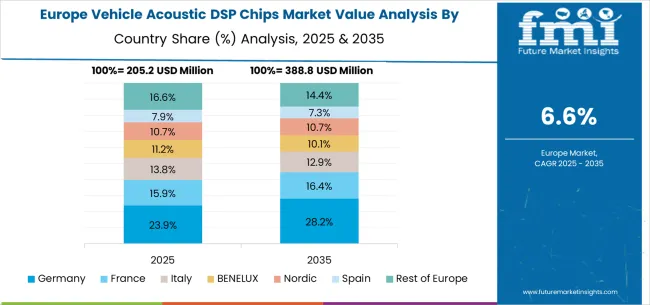
Germany maintains market leadership through automotive engineering excellence and premium vehicle production capabilities, demonstrating a solid 8.1% CAGR reflecting established automotive electronics expertise with sophisticated audio system integration. Market demonstrates established precision engineering base with advanced manufacturing capabilities across luxury and performance vehicle segments.
Automotive supplier network requires advanced audio processing technologies for component manufacturing and system integration supporting global automotive production requirements. Engineering services sector utilizes cutting-edge DSP solutions for prototype development and testing applications enabling innovation leadership. Quality standard development influences global automotive audio processing practices and technology adoption across international markets.
Research and development initiatives advance DSP chip design and application technologies while quality standard development impacts international automotive electronics practices. Supplier network integration enables advanced audio system optimization and performance enhancement supporting Germany's position as global automotive technology leader with comprehensive engineering expertise across multiple vehicle platforms.
Brazil represents emerging market growth through automotive industry development and consumer electronics adoption expansion, achieving a promising 7.6% CAGR reflecting increasing vehicle sophistication and rising consumer expectations for entertainment connectivity features. Market reflects increasing manufacturing capabilities and growing consumer demand for premium audio experiences across passenger and commercial vehicle segments. Government initiatives supporting automotive manufacturing create steady demand for advanced electronic systems integration.
Automotive production growth drives infotainment system adoption requiring DSP chip integration for competitive positioning in domestic and export markets. Consumer preference for multimedia entertainment systems increases demand for audio processing capabilities matching smartphone and consumer electronics quality standards. Export market development necessitates international quality standard compliance for audio system integration enabling global competitiveness.
Consumer electronics adoption drives infotainment system sophistication requirements supporting premium audio experiences. Export market development requires international audio quality standard compliance while technology partnerships enable advanced audio processing capability development. Government investment supports automotive electronics manufacturing sector expansion creating opportunities for domestic DSP chip adoption and sophisticated audio system integration across Brazil's expanding automotive industry.
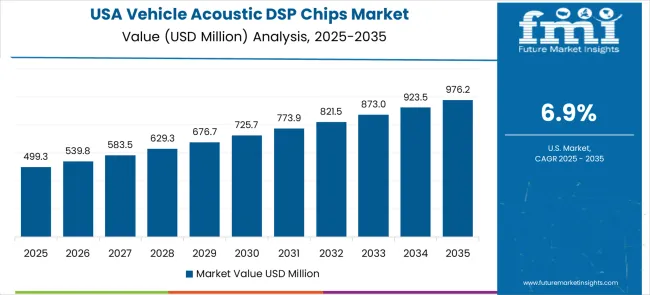
United States market demonstrates steady growth through premium vehicle segment expansion and advanced technology adoption initiatives, achieving a stable 6.8% CAGR reflecting established automotive industry with sophisticated infotainment system integration capabilities. Market reflects mature automotive manufacturing with ongoing innovation in electric vehicle adoption and autonomous driving development. Consumer preference for connectivity and entertainment features drives steady demand for high-performance audio processing solutions.
Electric vehicle adoption creates expanding requirements for advanced noise cancellation and audio enhancement systems supporting premium driving experiences. Autonomous vehicle development necessitates sophisticated audio processing for safety alerts and entertainment applications during automated driving scenarios. Premium automotive segments utilize cutting-edge DSP technology for competitive differentiation in luxury and performance markets.
Autonomous driving development creates demand for specialized audio processing capabilities supporting safety and entertainment integration. Consumer connectivity expectations drive advanced infotainment system integration while streaming services adoption requires high-quality audio reproduction and processing capabilities matching consumer electronics standards across diverse vehicle platforms and market segments.
United Kingdom demonstrates market stability through automotive industry modernization and premium technology adoption initiatives, maintaining a steady 6.1% CAGR reflecting established automotive manufacturing with ongoing electrification and connectivity enhancement programs. Market reflects mature automotive infrastructure with ongoing equipment modernization supporting premium vehicle development. Consumer preference for premium audio experiences drives steady demand for sophisticated DSP integration across luxury and performance vehicle segments.
Automotive electronics development includes advanced audio processing integration for performance and luxury vehicle segments requiring cutting-edge technology solutions. Research and development initiatives advance audio processing technology applications and system integration techniques supporting innovation leadership. Export market focus necessitates international quality standard compliance and competitive technology adoption enabling global market participation.
Export market participation necessitates international audio quality standard compliance while established automotive manufacturing expertise enables sophisticated audio system development supporting the United Kingdom's position in global premium automotive markets with advanced technology integration capabilities.
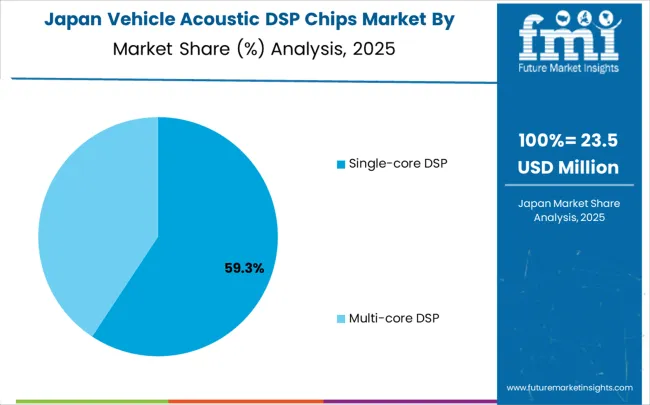
Japan maintains technological leadership through automotive electronics excellence and advanced semiconductor development capabilities, demonstrating a mature 5.3% CAGR reflecting established automotive industry with sophisticated audio system integration across premium and technology-focused vehicle segments. Market reflects mature industrial base with comprehensive expertise in automotive electronics and consumer device integration. Manufacturing technology leadership influences global automotive audio processing standards and applications development.
Automotive electronics manufacturing requires precision DSP solutions for production and quality control operations supporting global automotive supply chains. Consumer electronics expertise enables advanced infotainment system development and integration leveraging smartphone connectivity and multimedia processing capabilities. Technology export leadership includes sophisticated audio processing requirements for international automotive applications supporting global market presence.
Technology export leadership includes advanced audio processing system requirements for international markets while research and development initiatives advance automotive audio processing technologies and applications. Manufacturing precision and quality standards influence global automotive audio processing practices supporting Japan's continued leadership in automotive technology innovation with comprehensive semiconductor expertise across diverse vehicle platforms and advanced audio system integration capabilities.
Market structure reflects moderate concentration with established semiconductor companies maintaining significant positions while specialized automotive suppliers serve application-specific segments. Competition emphasizes technological innovation, automotive OEM partnerships, and audio processing performance optimization. Industry dynamics favor companies combining advanced semiconductor expertise with automotive application knowledge and system integration capabilities.
Tier 1 - Global Semiconductor Leaders: TI, NXP Semiconductors, STMicroelectronics, and similar multinational corporations dominate through comprehensive DSP portfolios, global automotive relationships, and advanced research capabilities. Competitive advantages include semiconductor innovation resources, established OEM partnerships, and manufacturing scale economies. Market positions reflect brand recognition and technology reputation across diverse automotive applications.
Tier 2 - Specialized Audio Semiconductor Providers: Companies like Analog Devices, Cirrus Logic, and Renesas Electronics focus on specific automotive applications or regional markets through specialized audio processing solutions. Competitive advantages include application expertise, customer service flexibility, and automotive market knowledge. Market positioning emphasizes audio performance specialization and automotive OEM relationship development.
Tier 3 - Regional and Emerging Competitors: Smaller companies including Chinese manufacturers like Hisilicon and C*Core Technology serve local automotive markets and cost-sensitive applications. Competitive advantages include cost competitiveness, regional automotive service capabilities, and customization flexibility. Market participation focuses on emerging automotive segments and specialized audio processing requirements.
| Item | Value |
|---|---|
| Quantitative Units | USD 867.1 million |
| Core Architecture | Single-core DSP, Multi-core DSP |
| Application | Passenger Car, Commercial Car |
| Regions Covered | North America, Latin America, Europe, East Asia, South Asia & Pacific, Middle East & Africa |
| Countries Covered | United States, Canada, Mexico, Germany, United Kingdom, France, Italy, Spain, Nordic, BENELUX, China, Japan, South Korea, India, ASEAN, Australia, New Zealand, Brazil, Chile, Kingdom of Saudi Arabia, GCC Countries, Turkey, South Africa |
| Key Companies Profiled | TI, NXP Semiconductors, STMicroelectronics, Analog Devices, onsemi, Renesas Electronics, Cirrus Logic, Microchip Technology, Rohm, Qualcomm |
| Additional Attributes | Dollar sales by architecture categories, regional demand trends across Asia Pacific, Europe, and North America, competitive landscape with player descriptions, adoption patterns across automotive applications, integration with infotainment systems and vehicle electronics, innovations in DSP technology and audio processing, development of specialized automotive applications with enhanced performance capabilities |
The global vehicle acoustic DSP chips market is estimated to be valued at USD 867.1 million in 2025.
The market size for the vehicle acoustic DSP chips market is projected to reach USD 1,754.2 million by 2035.
The vehicle acoustic DSP chips market is expected to grow at a 7.3% CAGR between 2025 and 2035.
The key product types in vehicle acoustic DSP chips market are single-core DSP and multi-core dsp.
In terms of application, passenger car segment to command 71.4% share in the vehicle acoustic DSP chips market in 2025.






Our Research Products

The "Full Research Suite" delivers actionable market intel, deep dives on markets or technologies, so clients act faster, cut risk, and unlock growth.

The Leaderboard benchmarks and ranks top vendors, classifying them as Established Leaders, Leading Challengers, or Disruptors & Challengers.

Locates where complements amplify value and substitutes erode it, forecasting net impact by horizon

We deliver granular, decision-grade intel: market sizing, 5-year forecasts, pricing, adoption, usage, revenue, and operational KPIs—plus competitor tracking, regulation, and value chains—across 60 countries broadly.

Spot the shifts before they hit your P&L. We track inflection points, adoption curves, pricing moves, and ecosystem plays to show where demand is heading, why it is changing, and what to do next across high-growth markets and disruptive tech

Real-time reads of user behavior. We track shifting priorities, perceptions of today’s and next-gen services, and provider experience, then pace how fast tech moves from trial to adoption, blending buyer, consumer, and channel inputs with social signals (#WhySwitch, #UX).

Partner with our analyst team to build a custom report designed around your business priorities. From analysing market trends to assessing competitors or crafting bespoke datasets, we tailor insights to your needs.
Supplier Intelligence
Discovery & Profiling
Capacity & Footprint
Performance & Risk
Compliance & Governance
Commercial Readiness
Who Supplies Whom
Scorecards & Shortlists
Playbooks & Docs
Category Intelligence
Definition & Scope
Demand & Use Cases
Cost Drivers
Market Structure
Supply Chain Map
Trade & Policy
Operating Norms
Deliverables
Buyer Intelligence
Account Basics
Spend & Scope
Procurement Model
Vendor Requirements
Terms & Policies
Entry Strategy
Pain Points & Triggers
Outputs
Pricing Analysis
Benchmarks
Trends
Should-Cost
Indexation
Landed Cost
Commercial Terms
Deliverables
Brand Analysis
Positioning & Value Prop
Share & Presence
Customer Evidence
Go-to-Market
Digital & Reputation
Compliance & Trust
KPIs & Gaps
Outputs
Full Research Suite comprises of:
Market outlook & trends analysis
Interviews & case studies
Strategic recommendations
Vendor profiles & capabilities analysis
5-year forecasts
8 regions and 60+ country-level data splits
Market segment data splits
12 months of continuous data updates
DELIVERED AS:
PDF EXCEL ONLINE
Vehicle-Mounted Payment Terminal Market Size and Share Forecast Outlook 2025 to 2035
Vehicle Scanner Market Size and Share Forecast Outlook 2025 to 2035
Vehicle-to-grid Market Size and Share Forecast Outlook 2025 to 2035
Vehicle Transfer Case Market Size and Share Forecast Outlook 2025 to 2035
Vehicle Barrier System Market Size and Share Forecast Outlook 2025 to 2035
Vehicle Cargo Box Market Size and Share Forecast Outlook 2025 to 2035
Vehicle Jump Starter Market Size and Share Forecast Outlook 2025 to 2035
Vehicle Moving Services Market Size and Share Forecast Outlook 2025 to 2035
Vehicle Security Sensor Market Size and Share Forecast Outlook 2025 to 2035
Vehicle To Vehicle Communication Market Size and Share Forecast Outlook 2025 to 2035
Vehicle Roadside Assistance Market Size and Share Forecast Outlook 2025 to 2035
Vehicle as a Service Market Size and Share Forecast Outlook 2025 to 2035
Vehicle Integrated Solar Panels Market Size and Share Forecast Outlook 2025 to 2035
Vehicle Networking Market Size and Share Forecast Outlook 2025 to 2035
Vehicle-to-Everything (V2X) Cybersecurity Market Size and Share Forecast Outlook 2025 to 2035
Vehicle Armor Market Size and Share Forecast Outlook 2025 to 2035
Vehicle Conversion Market Size and Share Forecast Outlook 2025 to 2035
Vehicle Health Monitoring Market Size and Share Forecast Outlook 2025 to 2035
Vehicle Tracking System Market Size and Share Forecast Outlook 2025 to 2035
Vehicle Radar Test System Market Size and Share Forecast Outlook 2025 to 2035

Thank you!
You will receive an email from our Business Development Manager. Please be sure to check your SPAM/JUNK folder too.
Chat With
MaRIA